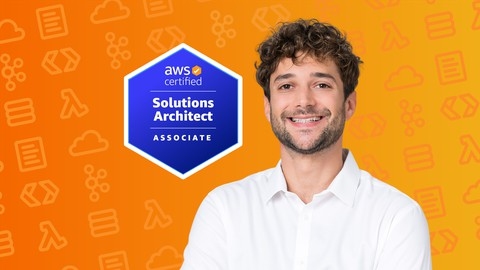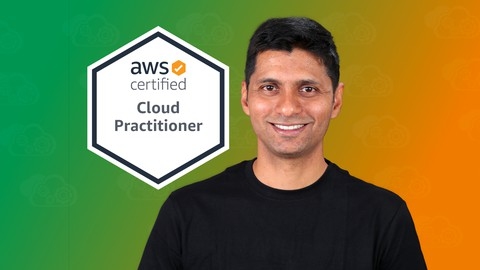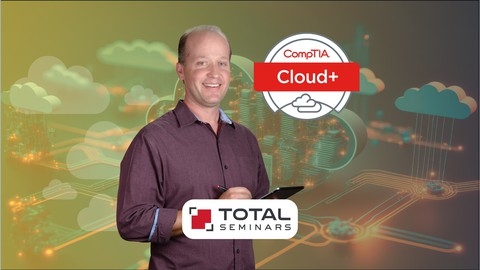Cloud computing has become the foundation of modern technology, enabling businesses and individuals to access and manage resources like servers, storage, and software over the internet.
Learning cloud computing empowers you to build scalable, cost-effective, and flexible applications, opening doors to diverse and exciting career opportunities in this ever-evolving field.
Finding the right cloud computing course on Udemy can be overwhelming, with countless options promising to teach you everything you need to know.
You’re looking for a course that goes beyond theory, providing practical experience and hands-on projects to solidify your understanding and prepare you for real-world challenges.
After carefully reviewing a vast selection of courses, we’ve identified "Ultimate AWS Certified Solutions Architect Associate SAA-C03" as the best overall cloud computing course on Udemy.
This comprehensive program covers everything you need to know about AWS, from fundamental concepts to advanced architectural design.
The course features detailed explanations, hands-on labs, and practice exams, making it ideal for those seeking a deep understanding of AWS and preparing for the highly sought-after AWS Certified Solutions Architect Associate certification.
While this is our top pick, we recognize that everyone’s learning style and goals are unique.
We’ve curated a collection of other outstanding cloud computing courses on Udemy, catering to various skill levels and areas of focus.
Whether you’re a beginner seeking an introduction to cloud concepts or an experienced professional wanting to specialize in specific cloud platforms or technologies, you’ll find the perfect course to advance your knowledge and career.
Ultimate AWS Certified Solutions Architect Associate SAA-C03
The course starts with an introduction to AWS, guiding you through creating an account, navigating the console, and understanding core services like IAM, EC2, and VPC.
You’ll learn hands-on how to manage users, groups, policies, and roles in IAM, as well as how to use the AWS CLI and SDK.
Next, you’ll dive deep into EC2, exploring instance types, security groups, purchasing options like Spot Instances, and storage solutions like EBS, EFS, and AMIs.
The course also covers critical concepts like high availability and scalability with Elastic Load Balancing and Auto Scaling Groups.
Moving on, you’ll learn about AWS databases like RDS, Aurora, DynamoDB, and ElastiCache, as well as networking services like Route 53 for DNS management.
The syllabus covers decoupling applications with SQS, SNS, and Kinesis, containerization with ECS, Fargate, and EKS, and serverless architectures with Lambda, API Gateway, and Step Functions.
It covers advanced S3 features like lifecycle policies, event notifications, and security aspects like encryption and access control.
You’ll also learn about CloudFront for content delivery, AWS Global Accelerator, and storage extras like Snowball, FSx, and Storage Gateway.
Additionally, the syllabus covers data analytics services like Athena, Redshift, and OpenSearch (formerly ElasticSearch), as well as machine learning services like Rekognition, Transcribe, and SageMaker.
Monitoring and auditing with CloudWatch, CloudTrail, and AWS Config are also covered in-depth.
The course prepares you for real-world scenarios with solution architecture discussions, disaster recovery strategies, and migration services like DMS and MGN.
You’ll also explore other services like CloudFormation, SES, Pinpoint, and AWS Batch.
Finally, the course provides exam preparation resources, including practice exams, exam tips, and links to whitepapers.
[NEW] Ultimate AWS Certified Cloud Practitioner CLF-C02
This comprehensive syllabus covers everything you need to ace the AWS Certified Cloud Practitioner certification exam.
The course starts by introducing you to the fundamentals of cloud computing, including its different types and the AWS Cloud overview.
You’ll get hands-on experience with the AWS console and services, ensuring you’re comfortable navigating the platform from the get-go.
One of the course’s highlights is the in-depth coverage of Identity and Access Management (IAM).
You’ll learn how to create users, groups, and policies, enabling you to manage access to AWS resources securely.
Additionally, you’ll explore multi-factor authentication (MFA), access keys, and the AWS Command Line Interface (CLI).
Moving on, you’ll dive into Elastic Compute Cloud (EC2), Amazon’s virtual server offering.
From launching instances to configuring security groups and SSH access, you’ll gain practical experience in managing compute resources.
The course also covers EC2 instance storage options, including Elastic Block Store (EBS), snapshots, and Amazon Machine Images (AMIs).
Load balancing and auto-scaling are essential concepts for building scalable and highly available applications in the cloud.
This course covers Elastic Load Balancing (ELB) and Auto Scaling Groups (ASG), equipping you with the skills to distribute traffic and automatically scale resources based on demand.
Storage is a critical aspect of any cloud infrastructure, and the course dedicates a comprehensive section to Amazon Simple Storage Service (S3).
You’ll learn about S3 buckets, security, versioning, replication, and storage classes, ensuring you can effectively manage and secure your data in the cloud.
Databases and analytics are covered in-depth, with lectures on Amazon Relational Database Service (RDS), Aurora, DynamoDB, Redshift, and Athena.
You’ll gain insights into choosing the right database solution for your needs and learn how to work with these services hands-on.
The course also explores other compute services like Elastic Container Service (ECS), Fargate, and AWS Lambda, introducing you to containerization and serverless computing concepts.
Deployment and infrastructure management are crucial aspects of cloud operations.
You’ll learn about CloudFormation for infrastructure as code, Elastic Beanstalk for application deployment, and various AWS developer tools like CodeCommit, CodeBuild, and CodePipeline.
Leveraging the AWS global infrastructure is essential for building highly available and low-latency applications.
The course covers Route 53 for DNS management, CloudFront for content delivery, and services like AWS Outposts and WaveLength for extending AWS infrastructure to on-premises and edge locations.
Cloud monitoring is another critical topic covered in the course.
You’ll learn about CloudWatch for metrics, logs, and alarms, as well as services like AWS Health Dashboard and X-Ray for monitoring and troubleshooting.
The course also covers networking concepts like Virtual Private Clouds (VPCs), subnets, security groups, and network access control lists (NACLs), ensuring you understand how to securely connect your resources in the AWS Cloud.
Security and compliance are paramount in the cloud, and the course dedicates a section to these topics.
You’ll learn about the shared responsibility model, DDoS protection with AWS WAF and Shield, encryption with AWS Key Management Service (KMS), and various security services like GuardDuty, Inspector, and Config.
Machine learning is an increasingly important aspect of modern applications, and the course introduces you to AWS services like Rekognition, Transcribe, Polly, and SageMaker.
Finally, the course covers account management, billing, and support topics, including AWS Organizations, Control Tower, pricing models, cost optimization tools, and support plans.
With hands-on labs, quizzes, and a practice exam, this course ensures you’re well-prepared for the AWS Certified Cloud Practitioner certification.
Introduction to Cloud Computing on AWS for Beginners [2024]
This comprehensive syllabus covers everything from the fundamentals to hands-on practice with AWS services.
You’ll begin by creating a free tier AWS account and learning essential IT concepts like client-server computing, storage types, networking, and virtualization.
This lays the groundwork for understanding cloud computing principles, service models, and deployment models.
Once you grasp the basics, you’ll dive into AWS’s core services.
Explore Identity and Access Management (IAM), Virtual Private Clouds (VPCs), security groups, and the AWS Command Line Interface (CLI).
Then, provision and manage Amazon EC2 instances, Auto Scaling groups, and load balancers to build scalable applications.
Storage is crucial, so you’ll learn to work with Elastic Block Store (EBS), Elastic File System (EFS), and the highly scalable Amazon S3 object storage service.
You’ll even create an S3 static website!
Databases are covered too - create an Amazon RDS database and read replica, plus try out the NoSQL DynamoDB service.
Automate deployments with AWS CloudFormation and Elastic Beanstalk while implementing CI/CD pipelines.
Optimize performance using Amazon Route 53 DNS and CloudFront content delivery.
Explore serverless with AWS Lambda functions and containers on Amazon ECS with Fargate.
Integrate services via EventBridge and API Gateway.
By the end, you’ll be ready to pursue AWS certifications like the Cloud Practitioner or Solutions Architect Associate exams.
GCP for Beginners - Become a Google Cloud Digital Leader
The course starts with a solid introduction to cloud computing and GCP, helping you create your first GCP account and understand the concept of regions and zones.
You’ll then dive into Google Compute Engine (GCE), learning how to create and manage virtual machines, set up HTTP web servers, and explore various cost-saving strategies like sustained use discounts, committed use discounts, and preemptible VMs.
As you progress, you’ll discover the power of managed services in GCP, including Google App Engine (GAE), Google Kubernetes Engine (GKE), Google Cloud Functions, and Google Cloud Run.
The course explains the differences between Infrastructure as a Service (IaaS), Platform as a Service (PaaS), and Software as a Service (SaaS), helping you understand the evolution of cloud computing and the benefits of serverless architectures.
Storage is a crucial aspect of any cloud infrastructure, and this course covers it in depth.
You’ll learn about block, file, and object storage in GCP, with hands-on experience using Cloud Storage.
The course also explores various database options, including Cloud SQL, Cloud Spanner, BigQuery, Firestore, and Memorystore, catering to both relational and NoSQL data models.
Security is a top priority in cloud computing, and the course dedicates a significant portion to this topic.
You’ll learn about security threats, Cloud Identity and Access Management (IAM), encryption with Cloud Key Management Service (KMS), and organizing GCP resources using projects, folders, and organizations.
The course also covers hybrid cloud setups using Cloud VPN and Cloud Interconnect.
DevOps practices are essential for efficient cloud operations, and the course dives into continuous integration, deployment, and delivery using GCP services.
You’ll explore infrastructure as code, site reliability engineering (SRE), and best practices for monitoring and logging with Cloud Operations.
The course also covers advanced topics like building loosely coupled applications with Cloud Pub/Sub, architecting big data flows, streaming data processing, and IoT solutions.
You’ll learn about data governance using Dataplex and API management with Apigee and Cloud Endpoints.
Machine learning (ML) and artificial intelligence (AI) are rapidly growing fields, and the course introduces you to ML concepts and how to leverage GCP’s pre-trained models and custom model training capabilities.
You’ll also explore responsible AI principles and the importance of data in ML projects.
The course concludes with a focus on digital transformation using GCP, covering infrastructure modernization, application modernization, and business platform modernization.
You’ll learn about cloud migration scenarios, cost management strategies, and best practices for scaling operations in GCP.
Throughout the course, you’ll encounter real-world scenarios and hands-on demonstrations that reinforce your understanding of the concepts.
The instructor provides clear explanations and practical examples, making it easy to follow along and apply the knowledge to your own projects.
AWS Certified Cloud Practitioner - AWS Certification
You’ll start by learning about the world before cloud and the challenges it posed, then dive into the advantages of cloud computing and get hands-on with creating an AWS account and exploring regions and availability zones.
Next, you’ll provision your first EC2 instance, create a web server on it, and understand key concepts like Amazon Machine Images (AMI), instance types, security groups, and key pairs.
As you progress, you’ll explore fundamental services like Amazon S3 for scalable storage, Amazon S3 Glacier for archiving, and EC2 Instance Store and Elastic Block Storage (EBS) for block-level storage.
You’ll also learn about Amazon Elastic File System (EFS) and FSx for file storage needs.
The course dives deep into databases, covering both relational databases like Amazon RDS and Aurora for OLTP workloads, as well as Amazon Redshift and EMR for OLAP and big data processing.
You’ll get hands-on with Amazon DynamoDB, a powerful NoSQL database, and understand use cases for Amazon ElastiCache.
Next, you’ll learn how to create private networks using Amazon VPC and subnets, configure network access with NACLs and security groups, and connect to on-premises networks using Direct Connect and VPN.
You’ll also master identity and access management using IAM users, groups, roles, and policies.
The course covers a wide range of security topics, including encryption at rest and in transit, Key Management Service (KMS), CloudHSM, AWS WAF for protecting web applications, and more.
You’ll set up monitoring using CloudWatch and CloudTrail, and learn how to use AWS Config for resource tracking.
You’ll dive into application integration and loose coupling using Amazon SQS, SNS, and Amazon MQ.
Content delivery and routing is covered in-depth with Amazon CloudFront CDN and Route 53 DNS service.
As you near the end, you’ll explore various migration strategies and services like AWS Snowball, Snowmobile, DataSync, and Database Migration Service (DMS).
You’ll learn about DevOps concepts and infrastructure-as-code using AWS CloudFormation.
The course concludes with an in-depth look at the AWS Well-Architected Framework and its pillars, along with the AWS Cloud Adoption Framework (CAF).
You’ll learn how to optimize for cost, performance, reliability, and security.
Throughout the course, you’ll find quizzes to test your understanding.
The course also includes a detailed cheat sheet for quick review and practice tests to prepare you for the certification exam.
By the end of this course, you’ll have a solid understanding of key AWS services and be well-prepared to ace the AWS Certified Cloud Practitioner exam.
Cloud Computing Fundamentals
The course begins with an introduction to cloud computing, providing a historical overview and explaining key concepts like virtualization and containerization.
You’ll learn what cloud computing is and how it’s being used in the real world.
Next, the course dives into the different cloud service models: Infrastructure as a Service (IaaS), Platform as a Service (PaaS), and Software as a Service (SaaS).
Through engaging lectures and a fun “Pizza as a Service” analogy, you’ll grasp the differences between these models and when to use each one.
You’ll also explore the various cloud deployment models, including public, private, and hybrid clouds.
The course helps you understand the characteristics of each model and guides you in choosing the right one for your needs.
To ensure you get the most out of cloud computing, the course covers best practices and common challenges.
You’ll learn how to select the best cloud provider, manage costs, ensure security, and handle issues like governance, compliance, and cloud migration.
Security is a critical aspect of cloud computing, and this course dedicates an entire section to it.
You’ll discover the security issues identified by the Cloud Security Alliance (CSA) and learn strategies to mitigate risks, such as end-to-end data encryption, secure data transfers, and access management.
The course also compares commercial and open-source cloud solutions, such as Amazon Web Services, Microsoft Azure, OpenStack, and Apache CloudStack.
You’ll be equipped with the knowledge to make informed decisions when choosing between these options.
As a bonus, the course even guides you through building your own private cloud at home using DevStack, an OpenStack-based solution.
This hands-on experience will deepen your understanding of cloud computing and give you practical skills.
Throughout the course, you’ll have the opportunity to test your knowledge with quizzes on topics like cloud service models, deployment models, security, and best practices.
Basics in Cloud Computing with SAP Cloud Platform
The course starts with an introduction to digital transformation, explaining what it is, its benefits, and real-world examples.
You’ll learn about key technologies driving digital transformation, such as the Internet of Things (IoT), big data, real-time analytics, machine learning, and unstructured data.
Next, the course dives into the basics of cloud computing.
You’ll explore how traditional IT landscapes operate and the challenges they face in meeting modern business expectations.
The course then introduces cloud computing, explaining what it is, the roles of cloud providers and consumers, and the benefits it offers.
You’ll see how cloud computing helps solve business challenges and understand the economics behind it.
The course then covers the five essential characteristics of cloud computing in detail, including virtualization and how it enables cloud computing.
You’ll learn about the three main cloud service models: Infrastructure as a Service (IaaS), Platform as a Service (PaaS), and Software as a Service (SaaS).
The course also explains the different cloud deployment options, including public, private, hybrid, and community clouds.
With the cloud computing foundation laid, the course introduces SAP Cloud Platform, a comprehensive PaaS offering.
You’ll learn what it is, its capabilities, purpose, and history.
The course explains how SAP Cloud Platform can fit into your organization and the different environments it supports, namely Cloud Foundry and SAP NEO.
The course then dives deeper into SAP Cloud Platform concepts, covering its mission statement, a high-level overview, data storage options, tools, SDKs, and data centers.
You’ll get hands-on experience with SAP Cloud Platform, starting with creating a trial account and logging in to the cockpit.
The practical part of the course involves deploying a Java web application on SAP Cloud Platform.
You’ll download the necessary Java Eclipse tools and SDK, configure Java on your local machine, set up Eclipse to connect with SAP Cloud Platform, develop a Java application, and then deploy and run it on the platform.
You’ll also get to deploy an HTML5 application on SAP Cloud Platform.
The course walks you through creating a new HTML5 application, using the Web IDE to edit the HTML5 file, and then deploying and running the application.
You’ll gain a solid understanding of cloud computing concepts and hands-on experience with SAP Cloud Platform.
AWS Business Essentials - The Business Value of AWS [2024]
This course dives deep into the fundamentals of cloud computing, providing a solid foundation for understanding how it differs from traditional IT models.
You’ll explore the various cloud computing deployment and service models, gaining insights into key concepts like scalability, elasticity, high availability, and fault tolerance.
The course then introduces you to Amazon Web Services (AWS), one of the leading cloud platforms.
You’ll get an overview of AWS’s global presence, network topology, pricing, and service level agreements (SLAs).
Hands-on lessons guide you through navigating the AWS Management Console, familiarizing you with the platform’s interface.
Next, you’ll explore key AWS services across compute, storage, databases, serverless, analytics, and machine learning.
The course demonstrates how to build highly available and fault-tolerant applications on AWS, leveraging the platform’s robust capabilities.
You’ll also learn about automation on AWS, including using AWS CloudFormation for infrastructure as code.
A significant portion of the course focuses on the business case for cloud computing.
You’ll understand the key business benefits and explore enterprise use cases for AWS cloud services.
The course equips you with the knowledge to build a compelling business case for cloud adoption and establish the associated costs.
For organizations considering a move to the cloud, the course covers AWS migration tools and the AWS Trusted Advisor service.
You’ll also learn about managing and operating in the cloud, including leveraging higher-level managed services and ensuring security on AWS.
The course even addresses how to avoid vendor lock-in, an important consideration for any enterprise.
You’ll gain a solid understanding of cloud computing fundamentals, a deep dive into AWS services and capabilities, and the business acumen to make informed decisions about cloud adoption.
TOTAL: Cloud Computing / CompTIA Cloud+ (CV0-003)
Throughout the course, you will gain a solid understanding of cloud deployment models, system requirements, storage, networking, compute, migration strategies, patch management, security, and troubleshooting.
The course begins by defining the cloud and exploring various deployment models such as public, private, community, and hybrid clouds.
You will learn about the interactions between cloud components and non-cloud components, as well as the importance of baselines and selecting the right architecture for your needs.
Next, the course dives into cloud storage, covering topics like storage types, provisioning, protection capabilities, access protocols, and management.
You will also learn about disaster recovery and business continuity planning in the context of cloud storage.
Moving on to cloud networking, you will explore network components, protocols, ports, Virtual Private Networks (VPNs), segmentation, and Software-Defined Networking (SDN).
The course also covers important considerations for networking in different cloud models.
In the cloud compute section, you will learn about CPU capabilities, memory requirements, performance and cost considerations, high availability, and disaster recovery for compute resources.
The course also introduces containers and orchestration, as well as additional compute considerations like serverless applications and APIs.
The course then covers migration types, workload management, virtualizing physical systems, migrating security, protocols, and services.
You will also learn about Virtual Desktop Infrastructure (VDI) and high availability in the cloud.
Planning patch management is another crucial topic covered in the course.
You will learn about manual and automated patch management, update types, automated workflows, backup types and targets, maintenance automation techniques and tasks, provisioning and deprovisioning, application life cycles, monitoring, and reporting.
Cloud security is a significant focus of the course, covering security policies, standards and compliance, data security and compliance controls, identity and access management, encryption, compute security, account management, segmentation, security tools and services, network hardening, application and OS security, and security automation and orchestration.
Finally, the course covers troubleshooting cloud solutions, including troubleshooting methodology, deployment, capacity, automation and orchestration, connectivity, security, and disaster recovery.
You will have the opportunity to work through hands-on labs and demos, reinforcing the concepts learned in each chapter.
These labs cover topics such as creating S3 buckets, EC2 instances, user accounts in AWS, and troubleshooting network and capacity problems.
By the end, you will have a solid foundation in cloud computing concepts and technologies, preparing you for the CompTIA Cloud+ (CV0-003) certification exam and real-world cloud deployments.
Distributed Systems & Cloud Computing with Java
This course takes you on a journey through the world of distributed systems and cloud computing, equipping you with the knowledge and practical skills needed to build scalable and robust applications.
Starting with an introduction to distributed systems, you’ll dive into cluster coordination services and distributed algorithms.
You’ll learn about leader election theory and get hands-on experience with Apache Zookeeper, a powerful tool for coordinating distributed systems.
The course covers Zookeeper’s client threading model, Java API, and provides valuable tips for debugging applications using Zookeeper.
Next, you’ll explore cluster management, service registration, and discovery.
You’ll learn how to implement service registries and discovery mechanisms, enabling your distributed components to seamlessly communicate and collaborate.
The course also covers network communication, with a focus on using HTTP in distributed systems.
You’ll implement HTTP servers and clients, analyze network packets, and understand message delivery semantics.
Serialization and deserialization techniques are covered to handle complex data delivery between distributed components.
One of the highlights of the course is the hands-on project where you’ll build a distributed document search system.
You’ll learn about TF-IDF, a popular information retrieval technique, and implement it in a parallel and distributed manner.
You’ll architect the system, implement worker nodes, and develop a search cluster coordinator and web application.
Load balancing is a crucial aspect of distributed systems, and this course has you covered.
You’ll learn about load balancing strategies, algorithms, and networking layers.
You’ll get practical experience with HAProxy, a widely-used load balancer, and even run it using Docker for platform independence.
Distributed message brokers play a vital role in enabling communication and data flow between distributed components.
The course introduces you to Apache Kafka, a popular distributed streaming platform.
You’ll build a Kafka cluster, learn how to create Kafka producers and consumers using Java, and explore scalability and pub/sub patterns.
You’ll even put your skills to the test by building a distributed banking system.
Distributed storage and databases are essential for handling large-scale data in cloud computing.
The course covers database sharding techniques, including dynamic sharding with consistent hashing.
You’ll learn about database replication, consistency models, and quorum consensus.
MongoDB, a popular NoSQL database, is used as a practical example, and you’ll learn how to scale it using data replication and sharding.
Finally, the course dives into cloud computing and deployment at a global scale.
You’ll be introduced to cloud computing concepts and gain hands-on experience with cloud deployment using compute instances and templates.
You’ll learn about instance groups, autoscaling, auto-healing, and multi-region deployment with global load balancing.
The course material is delivered through a combination of lectures, quizzes, and hands-on practice sessions, ensuring a well-rounded learning experience.


![[NEW] Ultimate AWS Certified Cloud Practitioner CLF-C02](/img/best-aws-courses-udemy/3142166_NEWUltimateAWSCertifiedCloudPractitionerCLF-C02.jpg)
![Introduction to Cloud Computing on AWS for Beginners [2024]](/img/best-aws-courses-udemy/3329962_IntroductiontoCloudComputingonAWSforBeginners2024.jpg)




![AWS Business Essentials - The Business Value of AWS [2024]](/img/best-cloud-computing-courses-udemy/3556979_AWSBusinessEssentials-TheBusinessValueofAWS2024.jpg)

